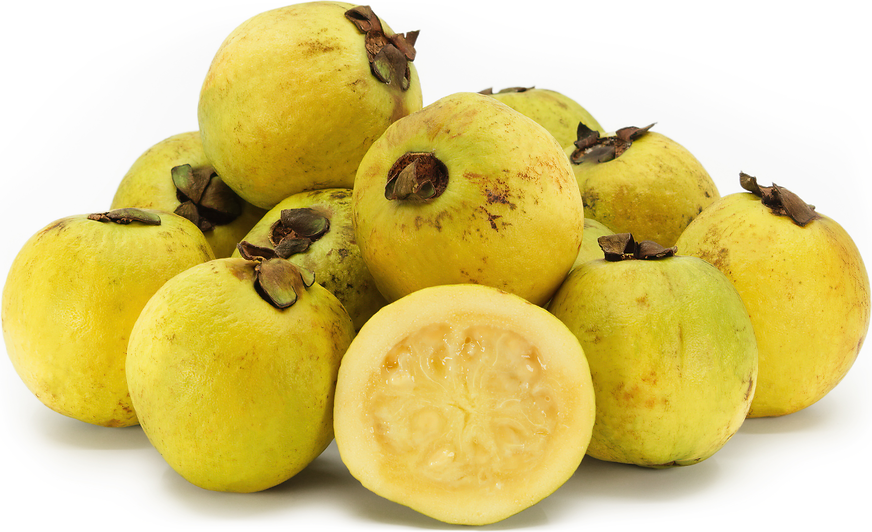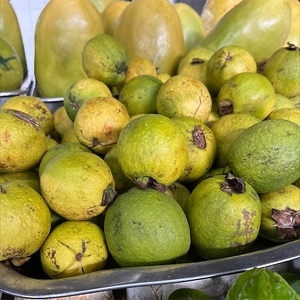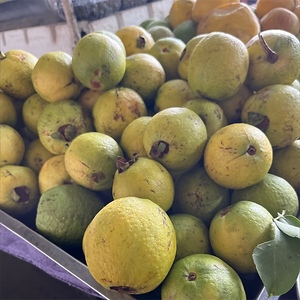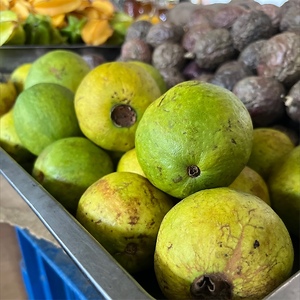


Sour Guavas
Estimated Inventory, lb : 0
Description/Taste
Sour guavas are small fruits, averaging 3 to 5 centimeters in diameter, and have a round, oval, to ovate shape with lumpy, curved edges. The skin is semi-smooth, taut, and thin, ripening from green to yellow-green with maturity, and there may be remnants of small sepals at the apex of the fruit. The skin is also delicate, often covered in brown spots, specks, and scratches, but these external markings show no indication of the flavor of the fruit. Underneath the skin, the flesh is firm, dense, crisp, and green when young, transitioning into a softer, tender, and slightly grainy consistency when ripe with a yellow hue. The flesh also contains a few small, flattened seeds, averaging 2 to 4 per fruit. Sour guavas have an astringent, tart, and sour flavor mixed with a subtle sweetness and contain floral, tropical, and bittersweet nuances.
Seasons/Availability
Sour guavas are available year-round, with a peak season in November through February.
Current Facts
Sour guavas, botanically classified as Psidium friedrichsthalianum, are a wild, tropical variety belonging to the Myrtaceae family. The acidic fruits grow on small trees or shrubs that reach 6 to 10 meters in height and are native to Central America, where they are incorporated into culinary recipes and beverages. Sour guavas are known by many different regional names, including Guayaba Agria in Colombia, Cas Ácida in Guatemala, Cas or Costa Rican guava in Costa Rica, Guayaba del Choco in Ecuador, Guayaba Montes in Mexico, Chaco guava in Ecuador, Guayaba de Fresco, and Acid guavas. Sour guavas are not commercially produced, but the plants are favored in home gardens for their resistance to disease, low maintenance, and high fruit yields. The variety is also used as a rootstock in commercial orchards for its hardiness. In the modern-day, Sour guavas are primarily consumed in refreshing beverages and are incorporated into desserts as an acidic, tropical flavor.
Nutritional Value
Sour guavas are an excellent source of vitamin C to strengthen the immune system, boost collagen production, and reduce inflammation, and are a source of fiber to regulate the digestive tract. The fruits also provide vitamin A to maintain healthy organ functioning, potassium to balance fluid levels within the body, and other nutrients, including iron, calcium, B vitamins, and phosphorus. In Central America, Sour guavas are valued for their high water content and are consumed in beverages as a natural diuretic.
Applications
Sour guavas have an acidic, bittersweet flavor well suited for sweet and savory preparations. The fruits are not traditionally consumed out of hand due to their sour taste, but young green guavas can be sprinkled with salt and eaten as a crunchy snack. Ripe Sour guavas can be tossed into salads, mixed into grain bowls, or pressed into juices, smoothies, and cocktails. The guavas can also be incorporated in jams, jellies, syrups, and honey or used to flavor cakes, flan, pastries, ice cream, and sorbet. The flesh can be used as a filling for baked goods as it contains a high pectin content, acting as a natural thickening agent. In Central America, Sour guavas are famous for flavoring frescos, refreshing fruit juice beverages mixed with sugar and water or milk. Frescos showcase the fruit’s tart flavor, and the guava’s sour nature is balanced with sugar to create an aromatic, tropical juice similar to the taste of guava and pink lemonade. Sour guava juice is also consumed throughout the Caribbean, where it is valued for its antioxidant content. Beyond fresh and cooked applications, Sour guavas can be pureed and frozen into ice cube trays, dropped into fruit punches, blended into smoothies, or incorporated into tangy sauces for roasted meats and seafood. Sour guavas pair well with other tropical fruits, including pineapple, passionfruit, coconut, strawberries, dragon fruit, and mangoes, ginger, mint, vanilla, and chocolate. The fruits should be used immediately when ripe for the best quality and flavor. Sour guavas can also be kept for a couple of days when stored in the refrigerator.
Ethnic/Cultural Info
Sour guavas are known as Cas guavas in Costa Rica, a name created from the dialect of the Boruca tribe. The Boruca are an indigenous people group that resides in the Talamanca mountains, now protected land for the tribe, and it is estimated there around approximately 2,000 members. The tribe is also sometimes known as Brunka or Brunca, recognized as one of the few indigenous groups of Central America that remained isolated during Spanish colonization. Each year, the tribe celebrates their resistance against the Spanish at the Fiesta de Los Diablitos or the Festival of the Little Devils. This multi-day celebration hosts a community-wide performance of mask-wearing actors, symbolizing the Spanish and the Boruca. On the last day of the festival, the Spanish character, typically represented as a bull, is burned, and a celebration of food, drink, dancing, and music is held. The Boruca have also preserved their rich heritage of agriculture, culinary practices, natural medicines, and cultural traditions. The name Cas guava was derived from the word “Kas” in Boruca, a native dialect spoken between members of the tribe. Cas guava is the most recognized name for the species in Costa Rica.
Geography/History
Sour guavas are native to Central America and have been growing wild since ancient times. The shrubs or small trees thrive in tropical to subtropical climates and are naturally found in humid forests ranging from Mexico to Colombia. Throughout history, Sour guavas have not been commercially cultivated, but the acidic fruits are planted in town centers, home gardens, and small orchards. Sour guavas are widely found in Costa Rica, with some experts believing the species’ point of origin may be within the country. Outside of Costa Rica, Sour guavas can be found throughout Central America, South America, and Southern Mexico. The fruits can also be found in the Philippines and select areas of California.










